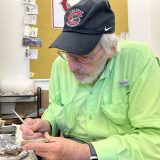Convergence in the Sciences Schmid College aims to develop the next generation of outstanding science leaders, scholars
March 15, 2017
On Thursday, May 4th, I will have the pleasure of sharing the stage with Professor Georgiana Bostean during Lunch at the Forum hosted by Chapman University’s Town and Gown. I will maintain the feeling of suspense surrounding that event by not revealing too much about our presentation, but it is worth noting that Professor Bostean and I will be discussing work that represents the intersection of many fields in the physical and social sciences. Such cross-disciplinary discussions and collaborations are vital in the study of complex problems, and have therefore become critical aspects in the modern era of discovery and translation of new knowledge.
Given the importance of educating students through a philosophy of interdisciplinary breadth layered upon disciplinary depth, Schmid College of Science and Technology is growing towards a strong sense of convergence across the entirety of our academic programs, faculty, and students. That word, convergence, is appropriate as it speaks to our rapid forward movement towards a common goal:
To create the next generation of outstanding critical thinkers, scholars, and thought leaders in science and technology.
Under One Roof
A clear example of this mission can be seen in the design and construction of the 140,000 square foot Center for Science and Technology. It is a completely unique and incredibly complex structure due to the vast breadth of academic and research programs to be housed there. By bringing all of Schmid College under one roof, with the various disciplines and activities intimately intermixed, the students will be immersed from day one into an educational environment that is simultaneously deep and broad.
As the students and faculty move through the building, they will encounter the full range of learning and scholarship that Schmid College has to offer, along with thoughtfully constructed spaces for organic collaboration and interactions, thereby maximizing the frequency of those exciting “collisions” that breed innovation and discovery.
Taking on Grand Challenges
The building alone cannot foster true convergence, however. To educate students in the practice of interdisciplinarity, it becomes important to challenge them to solve problems that can only be tackled via multiple vantage points. The Schmid College Grand Challenges Initiative presents precisely those kinds of problems. In this program, students are grouped into interdisciplinary teams as soon as they enter Chapman, and those teams choose a single Grand Challenge to study, and maybe even solve.
Working together from day one, our students will seek answers to massive questions in health, sustainability, technology, the environment and education – issues that touch all aspects of our lives. That team-based pursuit extends until the end of their second year, with the potential for it to extend through the entirety of their Chapman experience. Teams are encouraged to bring in expertise from outside the sciences as they dig deeper into their challenge and find that purely scientific innovation cannot solve society’s greatest issues. The Grand Challenges Initiative is, we believe, a revolutionary approach to science learning that breeds driven students who are empowered to take ownership of their education.
These are exciting times at Chapman, and we are poised to deliver innovative and impactful education to our amazing students while fostering innovation and discovery that will raise our international profile in the sciences. In all of those efforts, convergence is the key.
A version of this post was published in the Spring 2017 edition of the Chapman University Town and Gown Talk of the Town newsletter.
You can purchase tickets to the May 4, 2017 Lunch at the Forum here.


